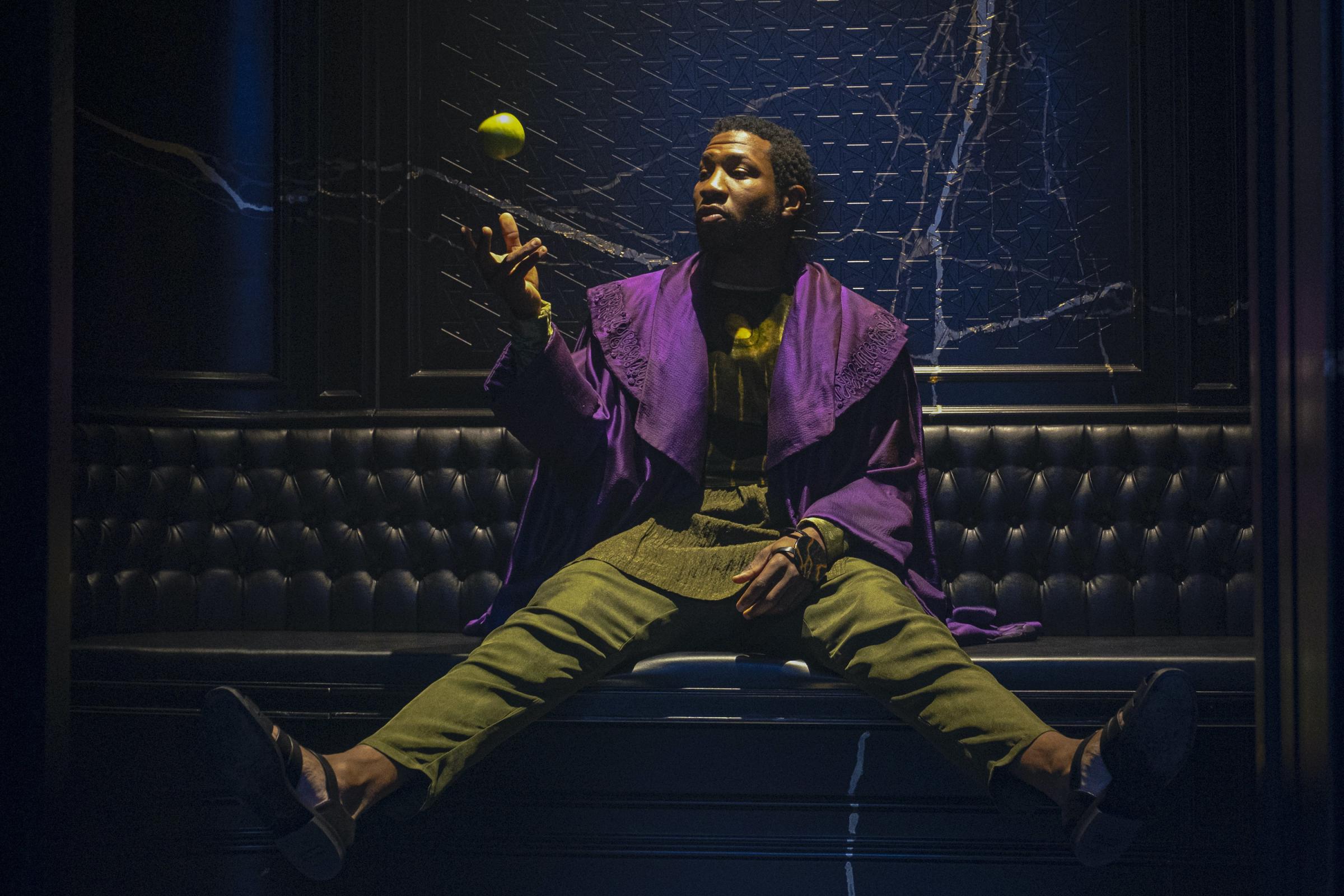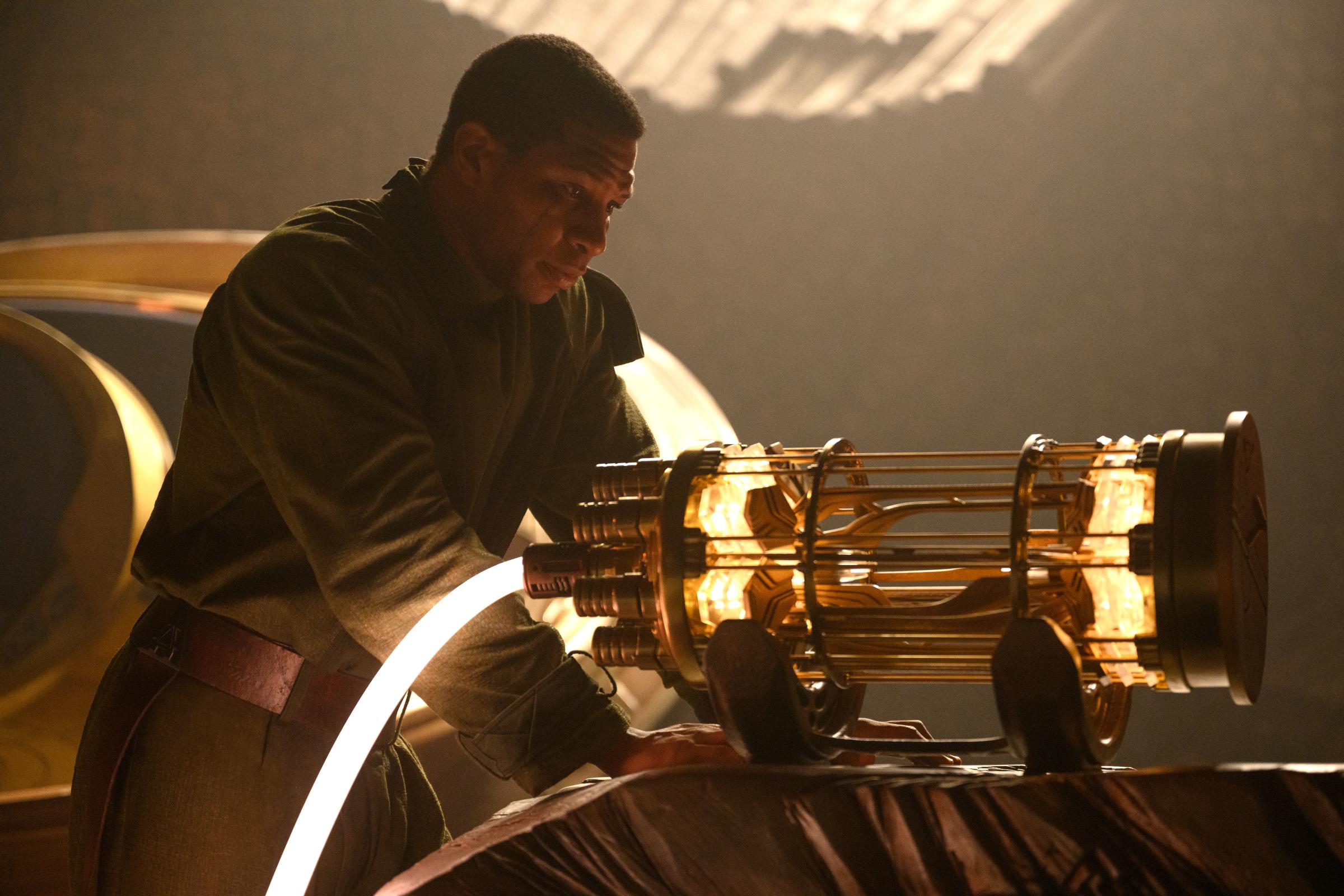Did you do your superhero homework? The Marvel Cinematic Universe has grown increasingly demanding of its audience: In order to understand what happens in Marvel’s latest film, Ant-Man and the Wasp: Quntumania, viewers will have to have watched not only the Ant-Man and Avengers films but also the Marvel TV series on Disney+, particularly Loki. That show introduced actor Jonathan Majors as the next big bad in the franchise but also seeded information about branching timelines, variants, and a multiversal war that are essential plot points in Quantumania.
That may be a big ask for Ant-Man fans. So far those movies have largely existed as comic diversions from the main action involving the MCU’s more powerful heroes like Thor and Captain America. Yet the new Ant-Man movie doesn’t spend much time explaining these concepts. Why are there multiple versions of the same character running around the movie? Who the heck is Jonathan Major’s Kang the Conquerer character and where did he come from? What is the multiverse? The film assumes that its audience has already gotten a download on all of these concepts from other Marvel properties and will likely leave those who have been skipping the MCU’s small-screen offerings befuddled.
Given that Majors’ Kang is being set up as the next Thanos-level villain in the MCU, understanding who he is and how he manipulates time and space will be essential to follow the plots of future Avengers films, like Avengers: The Kang Dynasty and Avengers: Secret Wars. If you didn’t watch Loki—or simply didn’t understand it—we’ve got you covered. Here’s a refresher on the show, the concept of the multiverse, and the origin story of Kang.
Read More: The MCU Has a Longstanding Villain Problem. Loki‘s Introduction of Jonathan Majors’ Kang the Conquerer Might Just Solve It
The multiverse and branching timelines played a role in Avengers: Endgame
Before we even dive into the events of Loki, we need to backtrack even further to Avengers: Endgame, which introduced the idea of time travel and branching timelines in the MCU. In that movie, the Avengers need to travel back in time to steal the Infinity Stones so they can defeat Thanos (Josh Brolin). However, Bruce Banner (Mark Ruffalo) learns from The Ancient One (Tilda Swinton) that if they take the Infinity Stones from different moments in time and do not return them, the Avengers will create a branching timeline that breaks off from their main “true” timeline. In order to prevent those fissures from happening, Captain America (Chris Evans) returns all the Infinity Stones to their original locations and moments in time after the Avengers defeat Thanos. Everything is fixed.
Except it’s not. The Avengers made one crucial mistake. They travel back in time to New York in 2012 when the original Avengers fought Thor’s brother Loki (Tom Hiddleston), who was trying to take over the world. They eventually captured Loki and the Infinity Stone that he was carrying. However when the new Avengers try to steal the Infinity Stone from the original Avengers, they flub the heist and Loki winds up getting his hand on the Infinity Stone. He uses it to disappear. The Avengers shrug it off.
The upshot? If a character takes an action that deviates from their preordained fate, they create a branching timeline, and that is bad for the universe for…reasons. Who decides what a character’s preordained fate is? Funny you should ask.
Read More: Breaking Down the Complicated Time Travel in Avengers: Endgame
Loki introduced Kang and the concept of variants

Loki begins with the scene from Avengers: Endgame where Loki stages his escape. Remember, this is 2012 Loki, the one who is still obsessed with ruling earth. He hasn’t reconciled with Thor (Chris Hemsworth) yet. He hasn’t helped save the Asgardian people. And he hasn’t been killed by Thanos.
Loki winds up in a desert but he’s quickly found by a group of people who call themselves the Time Variance Authority. He’s dragged into a court room and finds out that he has been labeled a “variant,” i.e. a version of a character that deviates from the character’s path, branching into a new timeline. The Time Variance Authority (TVA) “prunes” variants by killing them, thus maintaining the one, true sacred timeline.
Loki escapes, teams up with another Loki variant, this one a woman who goes by the name Sylvie (Sophia Di Martino). (Variants often look the same, but they can be different genders, species, ages, etc. Loki encounters older versions of himself, younger versions of himself, versions of himself that are a different race, and even a crocodile version of himself). Together, they hunt down the person who runs the Time Variance Authority with the goal of overthrowing his rule and setting all the hunted variants free to live in peace.
Eventually, they find their way to a man who calls himself He Who Remains. He is played by Jonathan Majors. (It’s worth watching the finale of the show even if you haven’t watched the preceding episodes because of Major’s monologue. He explains most of what you need to know for Quantumania, plus Majors turns in a whimsical yet terrifying performance that will get fans stoked for his future in the MCU.)
He Who Remains is the one who orders the TVA to prune branching timelines to create the one true timeline. He believes the branching timelines are a threat. He is able to predict everything that Loki and Sylvie will say, anticipate their every move. He doesn’t live linearly. He knows how their conversation ends, how time ends, how everything ends.
Kang the Conquerer is a variant of He Who Remains
He Who Remains explains that he is a genius from the future. His many different variants were the first ones to prove the multiversal theory—i.e. that there are many alternate timelines all happening simultaneously in parallel to our own—and discovered a way to travel across this multiverse. At first, things were fruitful: They shared ideas and technology. But, inevitably, some variants discovered new worlds and saw new timelines to be conquered. A multiversal war broke out. Each variant fought to preserve their universe and destroy the others. One variant proved particularly formidable. He called himself Kang. He threatened to end all life in the entire multiverse.
He Who Remains managed to defeat Kang by weaponizing a beast called Alioth who can eat time and space. He ended the multiversal war. He then isolated a single timeline and created the Time Variance Authority to prevent any timeline branches and ensure cosmic harmony. “If you think I’m evil, just wait til you meet my variants,” he tells the duo. But, he says, he’s tired. He Who Remains gives Loki and Sylvie the option of either ruling over the one true timeline themselves or killing him and unleashing chaos—and Kang.
The timelines begin to branch in Loki
Sylvie wants to kill He Who Remains. Loki tries to stop her but fails. Sylvie kills Kang and Loki finds himself in a universe in which Kang has seemingly already conquered the multiverse. There’s a giant statue of him at the Time Variance Authority headquarters.
Read More: Here’s What the Loki Finale Means for the Future of Marvel Movies
We don’t really know why Kang ended up in the Quantum Realm

In Quantumania, we find Kang not the conquerer of all universes but a man lost in the Quantum Realm with no means of escape. Kang vaguely refers to being banished to the Quantum Realm by his other variants because he posed a threat to them. It’s unclear when in the “timeline” this takes place or what happened to precipitate these events. Given that Kang can travel across the multiverse, the fabric of space-time doesn’t seem to really apply to him.
Perhaps after Sylvie killed He Who Remains, Kang re-emerged on one of the branching timelines, began a war, and was banished by his other variants. Maybe the universe in which Loki sees Kang take over the multiverse has yet to transpire in Ant-Man’s timeline. It’s all a little confusing, but presumably the second season of Loki will explain how Kang’s banishment fits into the tale of He Who Remains.
Ant-Man and the Wasp: Qunatumania hints at what will happen in Season 2 of Loki
This portion contains spoilers for the end-credits scenes in Quantumania.
After the credits roll on Quantumania we get two teasers. The first is of all the Kang variants meeting together. Hopefully, that means we’ll get to see Majors play several different versions of the villain, all with different personalities.
The second shows Hiddleston’s Loki and Loki character Mobius (Owen Wilson) at an early 1900s show about the space-time continuum being presented by a variant of Kang or perhaps even Kang himself (played, again, by Majors). In the comics, Kang frequently travels through time, taking on new identities as he does so. At one point he travels to the year 1901 and adopts the name Victor Timely, essentially using it as a disguise. An industrialist and inventor, he founds a city called Timely, Wisconsin, and builds it into a technological marvel. Perhaps Loki thinks that by traveling back in time and finding Kang he will be able to prevent the events that lead to Kang’s conquests.
More Must-Reads from TIME
- Donald Trump Is TIME's 2024 Person of the Year
- Why We Chose Trump as Person of the Year
- Is Intermittent Fasting Good or Bad for You?
- The 100 Must-Read Books of 2024
- The 20 Best Christmas TV Episodes
- Column: If Optimism Feels Ridiculous Now, Try Hope
- The Future of Climate Action Is Trade Policy
- Merle Bombardieri Is Helping People Make the Baby Decision
Write to Eliana Dockterman at eliana.dockterman@time.com